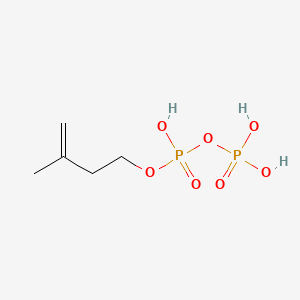| MeSH term | MeSH ID | Detail |
|---|---|---|
| Melanoma | D008545 | 69 associated lipids |
Isopentenyl pyrophosphate
Isopentenyl pyrophosphate is a lipid of Prenol Lipids (PR) class. Isopentenyl pyrophosphate is associated with abnormalities such as Tuberculosis, NAVAJO NEUROHEPATOPATHY and Cryptosporidiosis. The involved functions are known as Signal, Anabolism, T-Cell Activation, T-Cell Proliferation and isoprenoid biosynthetic process. Isopentenyl pyrophosphate often locates in Protoplasm, Host Cell, soluble, Plastids and Cell surface. The associated genes with Isopentenyl pyrophosphate are oxytocin, 1-desamino-(O-Et-Tyr)(2)-, HLA-E gene, RAP1A gene, Gene Family and Orthologous Gene. The related lipids are Steroids, Sterols and isopentenol.
Cross Reference
Introduction
To understand associated biological information of Isopentenyl pyrophosphate, we collected biological information of abnormalities, associated pathways, cellular/molecular locations, biological functions, related genes/proteins, lipids and common seen animal/experimental models with organized paragraphs from literatures.
What diseases are associated with Isopentenyl pyrophosphate?
Isopentenyl pyrophosphate is suspected in Tuberculosis, NAVAJO NEUROHEPATOPATHY, Cryptosporidiosis and other diseases in descending order of the highest number of associated sentences.
Related references are mostly published in these journals:
| Disease | Cross reference | Weighted score | Related literature |
|---|
Possible diseases from mapped MeSH terms on references
We collected disease MeSH terms mapped to the references associated with Isopentenyl pyrophosphate
PubChem Associated disorders and diseases
What pathways are associated with Isopentenyl pyrophosphate
Lipid pathways are not clear in current pathway databases. We organized associated pathways with Isopentenyl pyrophosphate through full-text articles, including metabolic pathways or pathways of biological mechanisms.
Related references are published most in these journals:
| Pathway name | Related literatures |
|---|
PubChem Biomolecular Interactions and Pathways
Link to PubChem Biomolecular Interactions and PathwaysWhat cellular locations are associated with Isopentenyl pyrophosphate?
Visualization in cellular structure
Associated locations are in red color. Not associated locations are in black.
Related references are published most in these journals:
| Location | Cross reference | Weighted score | Related literatures |
|---|
What functions are associated with Isopentenyl pyrophosphate?
Related references are published most in these journals:
| Function | Cross reference | Weighted score | Related literatures |
|---|
What lipids are associated with Isopentenyl pyrophosphate?
Related references are published most in these journals:
| Lipid concept | Cross reference | Weighted score | Related literatures |
|---|
What genes are associated with Isopentenyl pyrophosphate?
Related references are published most in these journals:
| Gene | Cross reference | Weighted score | Related literatures |
|---|
What common seen animal models are associated with Isopentenyl pyrophosphate?
There are no associated biomedical information in the current reference collection.
NCBI Entrez Crosslinks
All references with Isopentenyl pyrophosphate
Download all related citations| Authors | Title | Published | Journal | PubMed Link |
|---|---|---|---|---|
| Zeidler J and Lichtenthaler HK | Biosynthesis of 2-methyl-3-buten-2-ol emitted from needles of Pinus ponderosa via the non-mevalonate DOXP/MEP pathway of isoprenoid formation. | 2001 | Planta | pmid:11469599 |
| pmid:11514159 | ||||
| Hamano Y et al. | Cloning of a gene cluster encoding enzymes responsible for the mevalonate pathway from a terpenoid-antibiotic-producing Streptomyces strain. | 2001 | Biosci. Biotechnol. Biochem. | pmid:11515548 |
| Cipriani B et al. | Curcumin inhibits activation of Vgamma9Vdelta2 T cells by phosphoantigens and induces apoptosis involving apoptosis-inducing factor and large scale DNA fragmentation. | 2001 | J. Immunol. | pmid:11544338 |
| Huang Q et al. | Engineering Escherichia coli for the synthesis of taxadiene, a key intermediate in the biosynthesis of taxol. | 2001 | Bioorg. Med. Chem. | pmid:11553461 |
| Lange BM et al. | Isoprenoid biosynthesis. Metabolite profiling of peppermint oil gland secretory cells and application to herbicide target analysis. | 2001 | Plant Physiol. | pmid:11553758 |
| Evans PS et al. | In vitro stimulation with a non-peptidic alkylphosphate expands cells expressing Vgamma2-Jgamma1.2/Vdelta2 T-cell receptors. | 2001 | Immunology | pmid:11576216 |
| Phan RM and Poulter CD | Synthesis of (S)-isoprenoid thiodiphosphates as substrates and inhibitors. | 2001 | J. Org. Chem. | pmid:11578224 |
| Rohdich F et al. | The non-mevalonate pathway of isoprenoids: genes, enzymes and intermediates. | 2001 | Curr Opin Chem Biol | pmid:11578926 |
| Nakamura A et al. | Two distinct isopentenyl diphosphate isomerases in cytosol and plastid are differentially induced by environmental stresses in tobacco. | 2001 | FEBS Lett. | pmid:11591371 |
| pmid:11672736 | ||||
| Feurle J et al. | Escherichia coli produces phosphoantigens activating human gamma delta T cells. | 2002 | J. Biol. Chem. | pmid:11675382 |
| Cornish K et al. | Rubber molecular weight regulation, in vitro, in plant species that produce high and low molecular weights in vivo. | 2000 | Biomacromolecules | pmid:11710193 |
| Daubenberger CA et al. | Functional and structural similarity of V gamma 9V delta 2 T cells in humans and Aotus monkeys, a primate infection model for Plasmodium falciparum malaria. | 2001 | J. Immunol. | pmid:11714808 |
| pmid:11722180 | ||||
| Chen YH et al. | Probing the conformational change of Escherichia coli undecaprenyl pyrophosphate synthase during catalysis using an inhibitor and tryptophan mutants. | 2002 | J. Biol. Chem. | pmid:11744728 |
| Wesch D et al. | Differentiation of resting human peripheral blood gamma delta T cells toward Th1- or Th2-phenotype. | 2001 | Cell. Immunol. | pmid:11748927 |
| Yang D et al. | Structure of the Methanococcus jannaschii mevalonate kinase, a member of the GHMP kinase superfamily. | 2002 | J. Biol. Chem. | pmid:11751891 |
| Han YS et al. | Biosynthesis of anthraquinones in cell cultures of Cinchona 'Robusta' proceeds via the methylerythritol 4-phosphate pathway. | 2002 | Phytochemistry | pmid:11754943 |
| pmid:11785983 |
